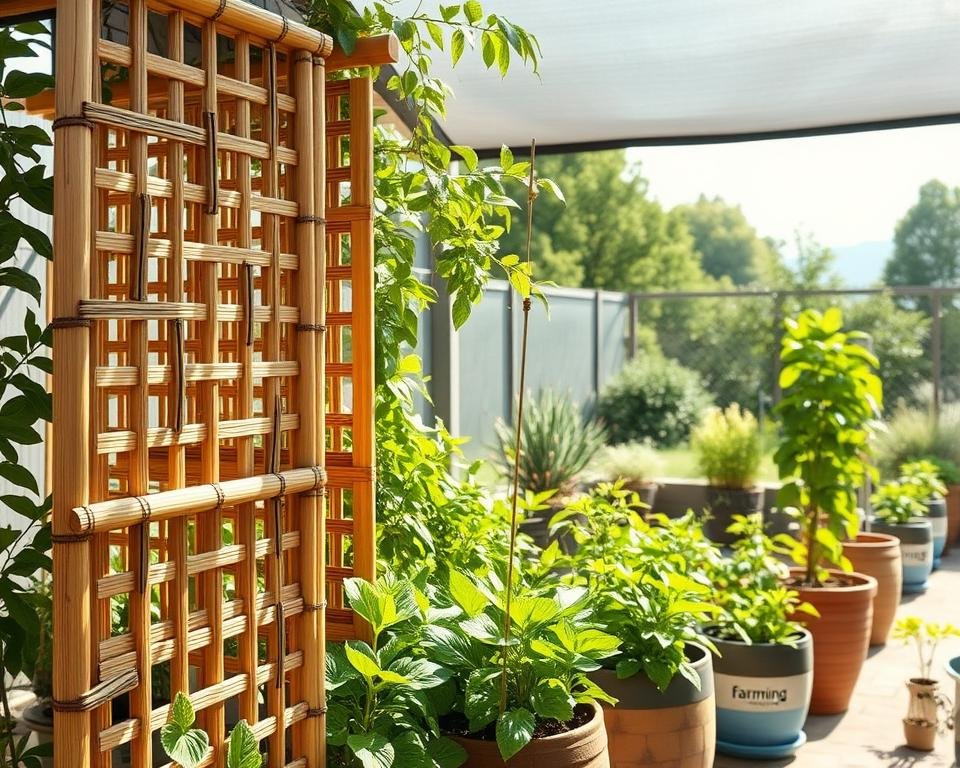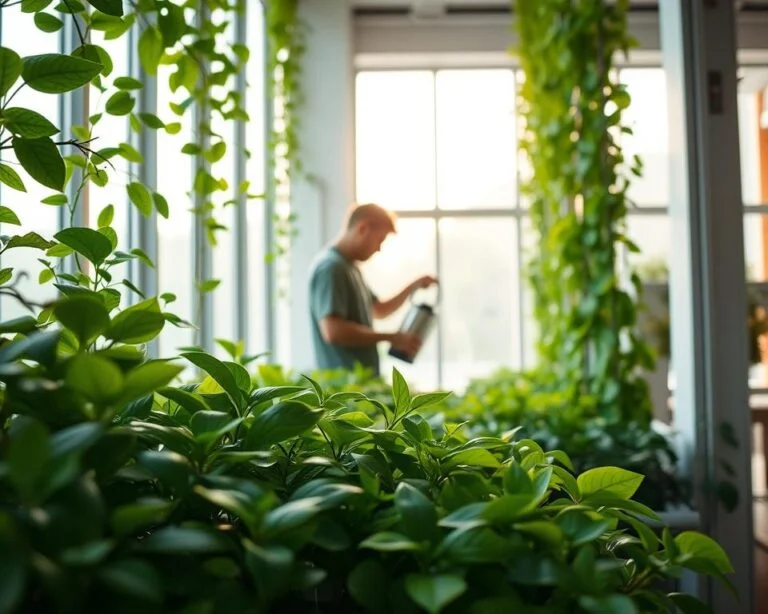Windbreak Solutions for Container Gardens
Watching your plants struggle against strong winds can be heartbreaking. Container gardens face special challenges in protecting plants from harsh winds. These winds can turn a lush garden into a stressed and damaged one.
Windbreak solutions are essential for container gardeners. Your plants need protection from winds that can harm leaves, dry out soil, and slow growth. With the right wind protection, you can create a strong and healthy garden environment.
Container gardening needs creative solutions for wind protection. Whether your garden is small or large, knowing how to protect your plants from wind damage is key. This helps keep them strong and beautiful.
Key Takeaways
- Windbreaks can reduce wind speeds by 50-80%
- Strategic container placement minimizes wind exposure
- Different materials and techniques offer varying levels of wind protection
- Natural and artificial windbreaks can be equally effective
- Proper wind protection leads to healthier container gardens
Understanding Wind Impact on Container Gardens
When you’re designing an outdoor container garden, it’s key to understand wind’s impact. Wind isn’t just a gentle breeze—it can be harmful. Container gardening in windy areas needs careful planning and watching.
Physical Plant Damage
Strong winds can harm your container plants a lot. Young plants with weak roots are most at risk. Wind can:
- Tear fragile leaves
- Break tender stems
- Uproot plants completely
Moisture Loss and Soil Challenges
Wind makes water evaporate fast, posing big challenges for container gardens. This quick moisture loss can cause:
- Dehydration of plant tissues
- Shriveling and wilting of leaves
- Potential soil erosion
Growth and Development Impacts
Wind doesn’t just damage plants—it affects their growth. Continuous wind stress can slow growth, weaken roots, and make plants more vulnerable. It’s vital to use protective strategies for a healthy outdoor container garden.
Selecting Wind-Resistant Plants for Containers

Creating a thriving container garden in windy areas needs careful plant selection. You want plants that can handle strong winds. They should also act as noise barriers and living fences.
Young plants are great for windy spots. They grow stronger roots than older plants. This makes them perfect for windy container gardens.
- Wind-resistant plant characteristics:
- Flexible stems
- Small, compact leaves
- Low growth habits
Here are some top wind-resistant plants for your garden:
| Plant Type | Wind Resistance | Additional Benefits |
|---|---|---|
| Rosemary | High | Culinary herb, aromatic |
| Butterfly Bush | High | Attracts pollinators |
| Ornamental Grasses | Excellent | Natural movement, visual interest |
| Lavender | Moderate to High | Fragrant, drought-tolerant |
To boost wind protection, mix tall plants with ground covers. Ornamental grasses like Pampas Grass add movement. They protect smaller plants and make your garden lively.
When planting in containers, add drainage material first. Fill about 25% of the pot with it. This helps with water and keeps plants stable in windy weather.
Windbreak Solutions
Protecting your container garden from wind damage is key. You can use sustainable wind mitigation techniques. These methods help make your outdoor space strong against harsh weather.

Wind can harm container gardens, causing damage and hurting plant health. Using natural wind deflectors is a good way to keep your green spaces safe.
Temporary Windbreak Materials
For fast protection, try these temporary options:
- Fabric screens
- Portable barriers
- Roll-up outdoor curtains
- Clear protective tarps
Permanent Windbreak Structures
For lasting protection, you need stronger solutions:
| Structure Type | Protection Level | Durability |
|---|---|---|
| Wooden Fences | High | Long-lasting |
| Stone Walls | Very High | Permanent |
| Lattice Panels | Moderate | Medium |
Natural Living Windbreaks
Green Giants are a top choice for natural wind protection. These remarkable trees grow fast, up to 3 feet a year. They can grow up to 50-60 feet tall. Their dense leaves make a great wind barrier and add beauty to your garden.
A well-planned windbreak can reduce wind speeds by up to 50%, protecting your container garden and improving plant health.
When picking windbreak solutions, think about your garden, local weather, and what you like. This way, you can make a lasting and green wind mitigation plan.
Strategic Container Placement and Design

To make effective environmental windscreens for your container garden, you need a good plan and design. Where you place your containers can greatly reduce wind impact. This helps protect your plants from harsh weather.
Here are some key strategies for eco-friendly wind protection:
- Position containers near existing structures like walls or fences
- Create multi-level container arrangements to block wind currents
- Use larger containers as natural windbreaks for smaller plants
- Group containers in clusters to minimize wind exposure
The secret to successful wind protection lies in understanding your specific garden’s microclimate. Watch how wind moves in your garden. Then, design your container layout to match.
Heavier ceramic or concrete containers can also help. They provide stability and act as environmental windscreens.
“Smart container placement is your first line of defense against wind damage.” – Garden Design Expert
Choose containers that naturally resist wind. Wider, shorter containers with lower centers of gravity are better than tall, narrow ones. Look for containers with features like weighted bases or aerodynamic shapes.
Your eco-friendly wind protection strategy should be flexible. Try different arrangements and see how your plants do in different winds.
Container Modifications for Wind Protection
To protect your container garden from wind, you need to make smart changes. These changes make your containers strong and stable. They turn weak spots into safe places for plants to grow.
Starting with bioshield wind barriers means knowing how to fix up your containers. The right steps can stop plants from getting hurt and help them grow well.
Weight Distribution Techniques
It’s key to spread weight evenly to keep containers steady. Here are some tips:
- Put heavy stuff like ceramic or stone at the bottom of containers
- Choose wider, lower containers for better wind protection
- Add sandbags around the base of containers for extra weight
Stabilizing Methods
Staying put is important when winds get strong:
- Stick sturdy stakes through the drainage holes in containers
- Use metal ties for bigger containers
- Group containers together to block wind
Drainage Considerations
Wind can mess with how water drains and stays in containers. Here’s how to fix it:
| Drainage Strategy | Wind Protection Benefit |
|---|---|
| Make sure containers have lots of drainage holes | This stops water from pooling when it’s windy |
| Put containers on a slight slope | This helps water drain and air move better |
| Use a mix that lets water drain through | This stops soil from washing away in windy weather |
With these changes, your garden can handle tough winds better.
Maintenance and Care in Windy Conditions
Keeping your container garden safe in windy weather is crucial. Start by learning how wind affects plants and use special care methods.
Watering is key in windy weather. Plants lose water faster, so they need more water. Here are some tips to protect your garden:
- Water deeply but less often to help roots grow strong
- Use organic mulch to keep soil moist
- Try drip irrigation for precise watering
- Check soil moisture often
Pruning is also important for plants to resist wind. Trimming helps plants grow strong and compact, making them more resilient.
“Preventative care is the cornerstone of successful container gardening in windy regions.” – Gardening Expert
Soil care is vital for plants to fight wind. Use rich, draining soil mixes that help plants stay strong. Here’s how to care for your soil:
- Add organic compost to improve soil
- Use slow-release fertilizers
- Rotate containers to ensure plants grow evenly
| Wind Condition | Recommended Action | Plant Impact |
|---|---|---|
| Light Breeze | Minimal intervention | Minimal stress |
| Moderate Wind | Temporary windbreaks | Moderate moisture loss |
| Strong Winds | Comprehensive protection | High risk of damage |
Keep a close eye on your garden and adjust care as needed. This way, your plants will thrive even in harsh winds.
Conclusion
Windbreak solutions are key for a successful container garden. They protect your plants from harsh winds, making your garden better. By using smart techniques, you can make your garden more durable.
Container gardening needs careful wind management. You can pick plants that resist wind or use barriers to block it. Studies show that using a mix of methods can boost wind protection by over 20%.
Knowing how wind affects your garden and using the right protection is crucial. You can use temporary or permanent barriers, or even natural ones. Each method helps your plants stay strong against the weather.
Don’t think that one windbreak method works for everyone. Try different approaches and see what works best for your garden. With time and effort, you can make your container garden thrive, even with wind challenges.







